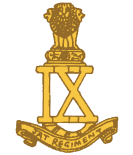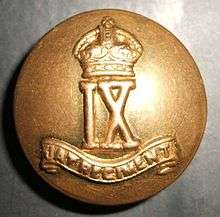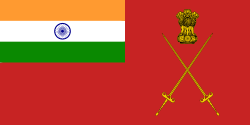Jat Regiment
| Jat Regiment | |
|---|---|
 Regimental Insignia of the Jat Regiment | |
| Active | 1795 – Present[1] |
| Country |
|
| Branch | Army |
| Type | Line Infantry |
| Size | 23 Battalions |
| Regimental Centre | Bareilly, Uttar Pradesh |
| Motto(s) | Sangathan Va Veerta (Unity And Valour) |
| War Cry | Jat Balwan, Jai Bhagwan (The Jat is powerful, Victory to god!) |
| Anniversaries | and East Pakistan - 1971 |
| Commanders | |
| Colonel of the Regiment | Lt Gen SK Saini, AVSM, YSM, VSM |
| Insignia | |
| Regimental Insignia | The Roman numeral nine representing its ninth position in the regimental hierarchy of the Indian Army of the 1920s. The insignia also has a bugle indicating the Light Infantry antecedents of two of its battalions. |
The Jat Regiment is an infantry regiment of the Indian Army. It is one of the longest serving and most decorated regiments of the Indian Army.[2] The regiment has won 19 battle honours between 1839 and 1947[3] and post independence 5 battle honours, eight Mahavir Chakra, eight Kirti Chakra, 32 Shaurya Chakras, 39 Vir Chakras and 170 Sena Medals.[2]
During its service of over 200 years, the regiment has participated in various actions and operations both in the pre- and post-independence India and abroad, including the First and the Second World Wars. Numerous battalions of the Jat Regiment fought in the First World War including the 14th Murray's Jat Lancers.[4]
History
The Jat people
The Jat is the agriculturist par excellence and the quintessential soldier who dominates the area comprising the Punjab States, Sindh, Haryana, Jammu, Rajasthan, and Western Uttar Pradesh. Whether Hindu, Sikh, or Muslim he constitutes the most important peasantry in both India and Pakistan. But it is the Hindu Jat of Haryana, Western Uttar Pradesh and Rajasthan who concerns us since it is he who forms the bulk of the composition of the Jat Regiment, renowned for its valour and dour steadfastness in battle. Although so near to the seat of Mughal power in Delhi, the Jats managed to preserve a semblance of independence. Primarily tillers, they are rustic par excellence and as fighting men have established for themselves a reputation of being determined, sturdy, fierce and desperate fighters. Their background makes them simple, hard working, honest and loyal - the essential qualities of good soldiers.
Primarily farmers throughout history, the first opposition to Aurangzeb's autocratic rule came from the Jats of Mathura. In 1669, the sturdy and hard working peasantry of Jats under the leadership of Gokla, zamindar of Tilpat, rose against and killed the Imperial Faujdar Abdun-Nabi. It took more than one year for the powerful Mogul forces to subdue the Jats. Gokul was killed and his family forcibly converted to Islam. But this did not deter the Jats and they once again rose in rebellion in 1685 under the leadership of Raja Ram. Akbar's tomb in Sikandra was plundered by them in 1688. Finally the Jats were defeated and Raja Ram slain in 1691. But the brave Jats again got organized under the leadership of Churamal and revolted. They continued a strong armed resistance against the Mughals after Aurangzeb's death.
Towards the end of Aurangzeb's reign, bands of Jats under individual leaders like Rajaram, Bhajja and Churamal carried out depredations around Delhi and Agra. They slowly increased their power. But whatever they had achieved was lost when Sawai Jai Singh II captured Churaman's stronghold of Thun in 1721. Till this time Jats were never united and they followed their individual village headsmen. But all this was changed by Badan Singh, the son of Churaman's brother, Bhao Singh. Even in the face of great difficulties, Badan Singh established his authority over almost of Agra and Mathura by wisdom, versatility and marriage alliances with powerful Jat families. Badan Singh died on 7 June 1756. His successor was Suraj Mal.
The Sikh religion was founded by Baba Guru Nanak (1469-1539), whose prime aim was to increase communal harmony between the Muslims and the Hindus. Initially the Sikhs were confined to the north West Indian region of Punjab (in modern India and Pakistan) and were mostly peasants from the sturdy & fierce "Jat" caste.
It is not until the decay of the Mogul Empire that the Jats again appear in history. One branch of them, settled south of Agra, mainly by bold plundering raids founded two dynasties at Bharatpur and Dholpur. Another branch, settled north-west of Delhi, who adopted the Sikh religion, ultimately made themselves dominant throughout the Punjab under Ranjit Singh, and were represented in their original home by the Phulkian houses of Patiala, Jind and Nabha. It was from this latter branch that the Sikh regiments of the Indian army were recruited.
Known for their military prowess, many Jats were recruited into the British-India Army during World War I. A large number of Jats serve is in the Indian Armed Forces and form one of the largest ethnic groups in the army.
Colonel Hoshiar Singh PVC won India's highest military medal, the Param Vir Chakra. Lt Gen Khem Karan Singh MVC was another great Jat soldier from Haryana and won the Maha Vir Chakra. Other Jats from Haryana who won the Maha Vir Chakra award are: Captain Devinder Singh Ahlawat MVC, Lt Col Dharam Singh MVC, Major M. S. Chaudhary MVC, Havildar Fateh Singh MVC, Naik Shishpal Singh MVC, Lance Naik Hari Singh MVC, Sepoy Man Singh MVC and Major General S. S. Kalaan MVC.
British Indian Army: 1795 to 1947
The Regiment claims its origins from the Calcutta Native Militia raised in 1795,[5] which later became an infantry battalion of the Bengal Army. The 14th Murray's Jat Lancers were formed in 1857.[5] After 1860, there was a substantial increase in the recruitment of Jats in the British Indian Army, however the Class Regiment, The Jats, was initially created as infantry units in 1897 from old battalions of the Bengal Army. In January 1922, at the time of the grouping of the Class Regiments of the Indian Army, the 9th Jat Regiment was formed by bringing under a single regiment, four active and one training battalion.
The British colonists were impressed by the martial qualities of the Jats that they soon started recruiting them in ever-increasing numbers into all branches of the Bengal Army. The 1st Battalion was raised as the 22nd Bengal Native Infantry in 1803.
The 2nd and 3rd Battalions were raised in 1817 and 1823 respectively. All three battalions had distinguished records of service including the winning of many honours during World War I. The 1st Battalion in particular served with great distinction in France and Iraq (then Mesopotamia) and was conferred the signal honour of being declared ‘Royal’ in addition to being made Light Infantry.

The Regiment saw a great deal of fighting in North Africa, Ethiopia, Burma, Malaya, Singapore, and Java-Sumatra. A large number of gallantry awards were won including a Victoria Cross and two George Crosses. At the end of the war the Regiment, in company with other regiments of the Indian Infantry, dropped the numeral 9 from its title and became simply the Jat Regiment.
Gates of Somnath temple
After the Battle of Kabul (1842), Governor General Lord Ellenborough had specifically ordered Major General William Nott who was commanding British-Indian forces, to recover a set of ornate gates, known as the Somnath Gates, which had been looted from India by the Afghans and hung at the tomb of Sultan Mahmud II.[6] A whole sepoy regiment, the 43rd Bengal Native Infantry (which later became the 6th Jat Light Infantry after the Indian Rebellion of 1857), was detailed to carry the gates back to India.[7]
Post-independence
_by_AC_Lovett_(1862-1919).jpg)
In free India the Jats maintained the high reputation they had created for themselves on the battle-fields of France and Flanders, Libya, Malaya and Burma to name a few. In Jammu and Kashmir 1947–48, the China War 1962, the conflicts with Pakistan in 1965 and 1971, and in Sri Lanka and Siachen, they have added to the laurels of the Regiment and the Army. But the actions of 3 Jat under Lt Col (now Brig Retd) Desmond Hayde initially on 1 September and then again on 21–22 September of crossing the Ichhogil Canal and capturing Dograi right up to Batapore-Attocke Awan and knocking on the very doors of Lahore speaks for itself about the battalion's leadership and the bravery of the troops. Recently in the 1999 Kargil conflict five of the Regiment’s battalions took part and once again displayed the excellent soldierly qualities that have made the Jats so well known amongst the community of fighting men. The performance of the Regiment’s battalions during the UN missions in Korea and Congo has been in keeping with its high standards. Again, it performed very well in the counter-insurgency operations that have kept the Indian Army busy ever since independence. [8]
Battle cry
The battle cry, adopted in 1955, in Hindi, is जाट बलवान, जय भगवान (IAST: Jāt Balwān, Jai Bhagwān), which means "The Jat is Powerful, Victory Be to God!".
Class Composition
The Jat Regiment's class composition consists of Jats from Western Uttar Pradesh, Haryana, Rajasthan and Delhi [9]
Regimental Battalions

- 2nd Battalion (former 15th Jat)
- 3rd Battalion (former 10th Jats)
- 4th Battalion
- 5th Battalion (Phillora Captors)
- 6th Battalion
- 7th Battalion (former 11th Jat)
- 8th Battalion
- 9th Battalion
- 11th Battalion
- 12th Battalion (former 31st Jat)
- 14th Battalion
- 15th Battalion
- 16th Battalion
- 17th Battalion
- 18th Battalion
- 19th Battalion
- 20th Battalion
- 21st Battalion
- 22nd Battalion
- 114 Infantry Battalion (TA) Jat
- 151 Infantry Battalion (TA) Jat
In 1979 the 1st Battalion was converted to the 2nd Battalion Mechanised Infantry Regiment
Gallantry awards
Battle honours
Pre-1947
- Nagpur & Afghanistan, 1839
- Ghuznee (Ghazni, Ali Masjid & Kandahar, 1842
- Cabool (Kabul), 1842
- Maharajpore, Sobraon, Mooltan, Goojrat (Gujarat), Punjab & China, 1858–59
- Kandahar 1880
- Burma 1885–87
- Afghanistan 1879–80
- China 1900
- La Bassée 1914
- Festubert 1914–15
- Shaiba, Ctesiphon, Khan al Baghdadi & Kut al Amara, 1915
- Neuve-Chapelle, France & Flanders, 1914–15
- Kut al Amara 1916
- Mesopotamia 1914–18
- North-West Frontier Province 1914–15 & 1917
- Afghanistan 1919
- Razabil & Burma, 1942–45
- Jitra, Kanglatongbi & Malaya, 1941–42
- Ninshigum, the Muars & North Africa, 1940–43
Post-1947[10]
- Zoji La & Rajauri, 1947
- Jammu and Kashmir 1947-48
- Phillora & Dograi 1965
- Jammu and Kashmir & East Pakistan 1971
Unit Citations
When a unit is decorated for counter-insurgency operations, unit citations are given instead of battle or theatre honours.
- 4th battalion, Nagaland 1995
- 7th battalion, J&K 1997, J&K 2003 & Operation Rhino 2016
- 11th battalion, Operation Rakshak 2011
- 34th battalion Rashtriya Rifles, J&K 1997
- 17th battalion, Operation Vijay 1999
- 16th battalion, Operation Rakshak 2005 & 2011
- 21st battalion, Operation Rhino 2009
Victoria Cross
- Risaldar Badlu Singh, 14th Murray's Jat Lancers attached to 29th Lancers (Deccan Horse), Palestine 1918.[11][12]
- Havildar Abdul Hafiz, 9th Jat Regiment, Imphal 1944.[11]
Maha Vir Chakra
- Lt. Col. (later Brig.) Desmond Hayde, 3 Jat, Dograi 1965
- Maj. Asaram Tyagi , 3 Jat, 1965
- Capt. Anuj Nayyar, 17 Jat, Kargil 1999
Vir Chakra
- Brig. Umesh Singh Bawa, 17 Jat, Kargil 1999
- Maj. Deepak Rampal, 17 Jat, Kargil 1999
- Havildar Kumar Singh Sogarwal, 17 Jat, Kargil 1999
- Havildar Shish Ram Gill, 8 Jat, Kargil 1999
Others
See also
References
- ↑ Army's Jat Regiment Best Marching Contingent in Republic Day 2007 Parade | India Defence Archived 2007-02-02 at the Wayback Machine.
- 1 2 Army's Jat Regiment Best Marching Contingent in Republic Day 2007 Parade | India Defence http://www.dsalert.org/gallantry-awards/shaurya-chakra
- ↑ "Archived copy". Archived from the original on 2011-06-09. Retrieved 2011-01-09. .
- ↑ The Times History of the War: The Battlefield of Europe. Woodward & Van Slyke
- 1 2 "The valiant Jat soldier - The Tribute". Retrieved 26 November 2014.
- ↑ Dalrymple (2013), pp.444–445
- ↑ "britishbattles.com". Archived from the original on 12 October 2007. Retrieved 23 October 2007.
- ↑ http://www.globalsecurity.org/military/world/india
- ↑ Martial castes of India by Mandeep Singh pg256
- ↑ "Official Website of Indian Army". Retrieved 26 November 2014.
- 1 2 We Were There - Medals and Awards - Victoria Cross Winners
- ↑ Risaldar Badlu Singh, VC Archived July 11, 2007, at the Wayback Machine.
- ↑ Press Trust of India (19 February 2014). "Jat Regiment's battalion gets environment award". Retrieved 26 November 2014.
- ↑ http://timesofindia.indiatimes.com/india/National-helpline-for-soldiers-Army-widows/articleshow/29729885.cms
Further reading
- War Services of the 9th Jat Regiment by Lieutenant Colonel W. L. Hailes details the military history of the Jat Regiment and of the Jat people between 1893 and 1937.
